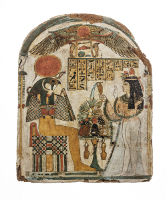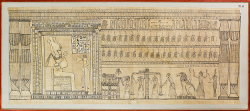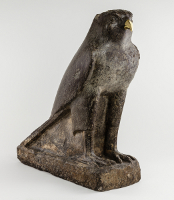Funerary Stela
Found in the Ramesseum at Thebes, this painted funerary stela was erected to commemorate the lady Djed-Khonsu-es-ankh. The deceased woman, in a diaphanous white gown, wears a cone of perfumed beeswax and a water lily on her head. She pours a libation over a table of food offerings and raises her hand to greet the seated god Re-Harakhty, a form of the ancient Egyptian sun god. The hieroglyphic signs offer a prayer asking the gods to supply food and drink for the survival of her spirit in the netherworld.
The inscription, a standard offering formula, reads:
An offering which the King gives to Re-Harakhty, the Great God, Lord of Heaven, that he may give invocation-offerings consisting of offerings and food to the Osiris, Lady of the House, the noblewoman, Djed-Khonsu-es-ankh, deceased, daughter of the priest of Amun-Ra, King of the Gods, Master of the Secrets of the Garments of the Gods, Ser- Djehuty.
Book of the Dead
The Book of the Dead was a collection of spells, hymns, and prayers intended to secure for the deceased safe passage to and sojourn in the other world. The sections of papyrus on display to the left and right are from one of these long scrolls, which was cut into fifteen sections in modern times.
The illustration to the left shows the judgement of the soul before Osiris, the god of the dead, who determines the deceased's worthiness to enter the next life by assessing his earthly deeds. The heart of Yartiuerow (the deceased) is being weighed in the balance against the feather of the goddess Maat, representing truth and justice. The jackal-god Anubis tips the balance in Yartiuerow's favor while the falcon-headed god Horus looks on and the ibis-headed Thoth, the secretary of the gods, records the favorable verdict. Yartiuerow himself stands on the right, his hands raised in jubilation, accompanied by the goddess Maat. Before him is a monster-part hippopotamus, part crocodile, and part lion- which would have annihilated him had the judgement been unfavorable.
The title of the Book of the Dead and its method of use are stated in the horizontal line at the top of the section exhibited to the right: "Beginning of the spells for going forth by day which raise the glorious ones (i.e., the dead) in the cemetery. To be said on the day of burial of entering in after going forth, by Osiris Yartiuerow, deceased." The vignette below shows part of the funeral procession. The sledge bearing the coffin is drawn by oxen. Two smaller sledges, each drawn by a man, follow. The one behind the coffcin bears the canopic box containing the four jars in which the viscera were preserved. On its lid lies a figure of the mortuary god Anubis in jackal form.
Statue of the God Horus
This statue represents the falcon god Horus, one of the most important ancient Egyptian gods. The beak and headdress have been restored to suggest the originals, which were almost certainly made of gold. A narrow passage from the base of the statue to the head may have been used for the insertion of cords to manipulate the original beak and headdress. In that way the statue could have functioned as an oracle-a medium through which the god made known his knowledge and purpose.
Human-Headed Winged Bull
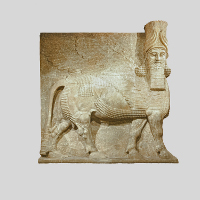 This colossal sculpture was one of a pair that guarded the entrance to the throne room of King Sargon II. A protective spirit known as a "lamassu", it is shown as a composite being with the head of a human, the body and ears of a bull, and the wings of a bird. When viewed from the side, the creature appears to be walking; when viewed from the front, to be standing still. Thus it is actually represented with five, rather than four, legs.
This colossal sculpture was one of a pair that guarded the entrance to the throne room of King Sargon II. A protective spirit known as a "lamassu", it is shown as a composite being with the head of a human, the body and ears of a bull, and the wings of a bird. When viewed from the side, the creature appears to be walking; when viewed from the front, to be standing still. Thus it is actually represented with five, rather than four, legs.
Deity Holding a Flowing Vase
These two statues once flanked a doorway leading into the temple of Nabu, the god of writing and of knowledge. Nearly identical sculptures were found at the entrances to other temples at Dur-Sharrukin. As well as representing minor deities, the figure also may have served as supports for as-yet-unidentified objects, as there are saucer-like hollows cut into the square blocks resting on their crowns.
Each of these gods holds a small vessel from which flow four streams of water - two rise over his shoulders to flow down his back and two stream down the front of his garment to his feet. Figures of this type are common in the art of the ancient Near East; they probably represent fertility deities who are embodiments of the life-giving and life-sustaining forces within fresh water.
The statues, when found, were in many pieces. These fragments were cleaned, soaked in a hardening solution, and then reassembled and restored by a member of the technical staff of the Oriental Institute.
Four-Faced God and Goddess

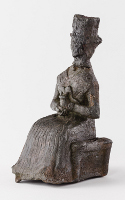 Illicit diggers found these four-faced statuettes, which may represent a god of the four winds and a goddess of rainstorms. The god wears a low cap with a pair of horns meeting above each face. He carries a scimitar in his right hand and places his left foot upon the back of a crouching ram. The goddess's tall crown, again with a pair of horns above each face, has the shape of a temple facade or altar. She grasps in her hands a vase from which flow streams of water; a rippled water pattern covers her garment.
Illicit diggers found these four-faced statuettes, which may represent a god of the four winds and a goddess of rainstorms. The god wears a low cap with a pair of horns meeting above each face. He carries a scimitar in his right hand and places his left foot upon the back of a crouching ram. The goddess's tall crown, again with a pair of horns above each face, has the shape of a temple facade or altar. She grasps in her hands a vase from which flow streams of water; a rippled water pattern covers her garment.
Cylinder Seal
 This cylinder seal was dedicated to a little-known goddess, Ninishkun, who is shown interceding on the owner's behalf with the great goddess Ishtar. Ishtar places her right foot upon a roaring lion, which she restrains with a leash. The scimitar in her left hand and the weapons sprouting from her winged shoulders indicate her war-like nature.
This cylinder seal was dedicated to a little-known goddess, Ninishkun, who is shown interceding on the owner's behalf with the great goddess Ishtar. Ishtar places her right foot upon a roaring lion, which she restrains with a leash. The scimitar in her left hand and the weapons sprouting from her winged shoulders indicate her war-like nature.
Pazuzu Demon
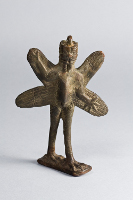 The demon Pazuzu represented by this figurine stands like a human but has a scorpion's body, feathered wings and legs, talons, and a lion-like face on both front and back. Pazuzu, the "king of the evil wind demons," was not entirely unfriendly to mankind. As an enemy of the dreaded Lamashtu demon, bearer of sickness especially to women and children, Pazuzu is often portrayed on amulets used as protection in childbirth. The ring at the top of this figurine suggests that it was such an amulet.
The demon Pazuzu represented by this figurine stands like a human but has a scorpion's body, feathered wings and legs, talons, and a lion-like face on both front and back. Pazuzu, the "king of the evil wind demons," was not entirely unfriendly to mankind. As an enemy of the dreaded Lamashtu demon, bearer of sickness especially to women and children, Pazuzu is often portrayed on amulets used as protection in childbirth. The ring at the top of this figurine suggests that it was such an amulet.
Canaanite Statuette
 This statuette of a god may have been the cult figure in the Canaanite temple in the ruins of which it was found. Cast in bronze and covered with gold leaf, it is an idol of the type forbidden by the much later Hebrew prophets. The identity of this bearded and enthroned deity is uncertain but is most likely to be El-the chief god of the pantheon and father of the other gods.
This statuette of a god may have been the cult figure in the Canaanite temple in the ruins of which it was found. Cast in bronze and covered with gold leaf, it is an idol of the type forbidden by the much later Hebrew prophets. The identity of this bearded and enthroned deity is uncertain but is most likely to be El-the chief god of the pantheon and father of the other gods.

